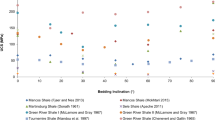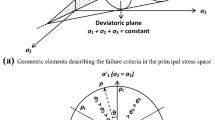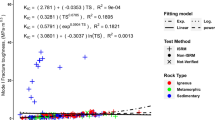Abstract
This study was focused on investigating the correlations between the physical and mechanical properties and geostatistical analysis of the shale rock based on the experimental data and the data collected from various research studies. In this study, over 250 data were used to characterize the shale rock behavior. The compressive strength and tensile strength of the shale rock investigated varied up to 200 and 13 MPa respectively. The shale rock was characterized based on the density, modulus of elasticity, fracture toughness and tensile strength and correlating the properties to compression strength and pulse velocity. Based on the statically analysis, the density of shale was in the range of 1.70–2.78 gm/cm3. Vipulanandan correlation model was effective in relating the modulus of elasticity, pulse velocity, fracture toughness with the compressive strength of the rocks. There was no direct correlation between the compressive strength and density or tensile strength and density of the shale rock. The new Vipulanandan failure model has been used to not only better quantify the tensile strength but also to predict the maximum shear stress of the rock. The prediction of the Vipulanandan failure model for shale rock type was also compared to the Mohr–Coulomb failure model. The Vipulanandan failure model has a maximum shear stress limit were, as the Mohr–Coulomb failure model did not have a limit on the maximum shear stress. Based on the Vipulanandan failure model the maximum shear stresses produced by the shale was 103 MPa. Based on the coefficient of determination (R2) and the root mean square error values, the Vipulanandan failure model predicted the results better than the Mohr–Coulomb model.










Similar content being viewed by others
References
Butt AS (2012) Shale characterization using X-ray diffraction. Doctoral dissertation, thesis, Master of Engineering, Universitas Dalhousie, Halifax, Nova Scotia
Cannaday FX (1964) Modulus of elasticity of a rock determined by four different methods, Report of Investigations U.S. Bureau of Mines 6522
Fjar E, Holt RM, Raaen AM, Risnes R, Horsrud P (2008) Petroleum related rock mechanics, vol 53. Elsevier, New York
Josh M, Esteban L, Delle Piane C, Sarout J, Dewhurst DN, Clennell MB (2012) Laboratory characterization of shale properties. J Pet Sci Eng 88:107–124
Juki MI, Awang M, Annas MMK, Boon KH, Othman N, Roslan MA, Khalid FS (2013) Relationship between compressive, splitting tensile and flexural strength of concrete containing granulated waste Polyethylene Terephthalate (PET) bottles as fine aggregate. In: Advanced materials research, vol 795. Trans Tech Publications, pp 356–359. https://doi.org/10.4028/www.scientific.net/AMR.795.356
Karakus M, Kumral M, Kilic O (2005) Predicting elastic properties of intact rocks from index tests using multiple regression modelling. Int J Rock Mech Min Sci 42(2):323–330
Ludovico-Marques M, Chastre C, Vasconcelos G (2012) Modelling the compressive mechanical behaviour of granite and sandstone historical building stones. Constr Build Mater 28(1):372–381
Meng Z, Pan J (2007) Correlation between petrographic characteristics and failure duration in clastic rocks. Eng Geol 89(3):258–265
Mohammed AS (2016) Effect of temperature on the rheological properties with shear stress limit of iron oxide nanoparticle modified bentonite-drilling muds. Egypt J Pet 26:791–802
Mohammed AS (2017a) Electrical resistivity and rheological properties of sensing bentonite-drilling muds modified with lightweight polymer. Egypt J Pet 27:55–63
Mohammed A (2017b) Vipulanandan model for the rheological properties with ultimate shear stress of oil well cement modified with nanoclay. Egypt J Pet. https://doi.org/10.1016/j.ejpe.2017.05.007
Mohammed AS (2017c) Property correlations and statistical variations in the geotechnical properties of (CH) clay soils. Geotech Geol Eng 36(1):267–281
Mohammed A, Mahmood W (2018) Vipulanandan failure models to predict the tensile strength, compressive modulus, fracture toughness and ultimate shear strength of calcium rocks. Int J Geotech Eng. https://doi.org/10.1080/19386362.2018.1468663
Mohammed AS, Vipulanandan C (2014) Compressive and tensile behavior of polymer treated sulfate contaminated CL soil. Geotech Geol Eng 32(1):71–83
Mohammed A, Vipulanandan C (2015) Testing and modeling the short-term behavior of Lime and Fly Ash treated sulfate contaminated CL soil. Geotech Geol Eng 33(4):1099–1114
Moos D, Peska P, Finkbeiner T, Zoback M (2003) Comprehensive wellbore stability analysis utilizing quantitative risk assessment. J Petrol Sci Eng 38(3):97–109
Nam MS, Vipulanandan C (2010) Relationship between texas cone penetrometer tests and axial resistances of drilled shafts socketed in Clay Shale and limestone. J Geotech Geoenviron Eng 136(8):1161–1165
Omar M (2017) Empirical correlations for predicting strength properties of rocks—United Arab Emirates. Int J Geotech Eng 11(3):248–261
Ozturk CA, Nasuf E (2013) Strength classification of rock material based on textural properties. Tunn Undergr Space Technol 37:45–54
Pells PJN (2004) Substance and mass properties for the design of engineering structures in the Hawkesbury sandstone. Aust Geomech 39(3):1–21
Rajabzadeh MA, Moosavinasab Z, Rakhshandehroo G (2012) Effects of rock classes and porosity on the relation between uniaxial compressive strength and some rock properties for carbonate rocks. Rock Mech Rock Eng 45(1):113–122
Sabatakakis N, Koukis G, Tsiambaos G, Papanakli S (2008) Index properties and strength variation controlled by microstructure for sedimentary rocks. Eng Geol 97(1):80–90
Sandrea R (2012) Evaluating production potential of mature US oil, gas shale plays. Oil Gas J 110(12):58
Schmidt RA (1976) Fracture-toughness testing of limestone. Exp Mech 16(5):161–167
Swapnil K, Kim MG, Vipulanandan C (2004) Nondestructive properties of Clayshale and Limestone in Dallas, Texas. In: Gulf rocks 2004, the 6th North America rock mechanics symposium (NARMS). American Rock Mechanics Association
Usluogullari OF, Vipulanandan C (2011) Stress–strain behavior and California bearing ratio of artificially cemented sand. J Test Eval 39(4):1–9
Vipulanandan C, Nam E (2009) Drilled shaft socketed in uncemented clay shale. Proceedings, foundation congress 2009. Contemporary topics in deep foundations, ASCE, GSP 185, pp 151–158
Vipulanandan C, Mohammed AS (2014) Hyperbolic rheological model with shear stress limit for acrylamide polymer modified bentonite-drilling muds. J Petrol Sci Eng 122:38–47
Vipulanandan C, Mohammed AS (2015a) Characterizing the hydraulic fracturing fluid modified with nano silica proppant. AADE-15-NTCE-38, CD Proceeding, San Antonio, Texas, April 2015
Vipulanandan C, Mohammed A (2015b) Effect of nanoclay on the electrical resistivity and rheological properties of smart and sensing bentonite drilling muds. J Petrol Sci Eng 130:86–95
Vipulanandan C, Mohammed A (2015c) XRD and TGA, swelling and compacted properties of polymer treated sulfate contaminated CL soil. J Test Eval 44(6):2270–2284
Vipulanandan C, Mohammed A (2015d) Smart cement modified with iron oxide nanoparticles to enhance the piezoresistive behavior and compressive strength for oil well applications. Smart Mater Struct 24(12):125020
Vipulanandan C, Mohammed A (2015e) Smart cement rheological and piezoresistive behavior for oil well applications. J Petrol Sci Eng 135:50–58
Vipulanandan C, Mohammed A (2017a) Rheological properties of piezoresistive smart cement slurry modified with iron-oxide nanoparticles for oil-well applications. J Test Eval 45(6):2050–2060
Vipulanandan C, Mohammed A (2017b) Smart cement compressive piezoresistive, stress–strain, and strength behavior with nanosilica modification. J Test Eval. https://doi.org/10.1520/JTE20170105
Vipulanandan C, Mohammed A (2018) New Vipulanandan failure model and property correlations for sandstone, shale and limestone rocks. In: IFCEE 2018, pp 365–376
Vipulanandan C, Mohammed A (2018) New Vipulanandan failure model and property correlations for sandstone, shale and limestone rocks. IFCEE 2018:365–376
Vipulanandan C, Krishnamoorti R, Mohammed A, Boncan V, Narvaez G, Head B, Pappas JM (2015) Iron nanoparticle modified smart cement for real time monitoring of ultra deepwater oil well cementing applications. In: Offshore technology conference. Offshore technology conference
Vipulanandan C, Mohammed A, Samuel RG (2017) Smart bentonite drilling Muds modified with iron oxide nanoparticles and characterized based on the electrical resistivity and rheological properties with varying magnetic field Strengths and temperatures. OTC-MS-270626
Vipulanandan C, Mohammed A, Ganpatye AS (2018a) Smart cement performance enhancement with nano Al2O3 for real time monitoring applications using Vipulanandan models. In: Offshore technology conference. Offshore technology conference
Vipulanandan C, Mohammed A, Samuel RG (2018b) Fluid loss control in smart bentonite drilling mud modified with nanoclay and quantified with Vipulanandan fluid loss model. In: Offshore technology conference. Offshore technology conference
Wang JA, Park HD (2002) Fluid permeability of sedimentary rocks in a complete stress–strain process. Eng Geol 63(3):291–300
Yesiloglu-Gultekin N, Gokceoglu C, Sezer EA (2013) Prediction of uniaxial compressive strength of granitic rocks by various nonlinear tools and comparison of their performances. Int J Rock Mech Min Sci 62:113–122
You M (2015) Strength criterion for rocks under compressive-tensile stresses and its application. J Rock Mech Geotech Eng 7(4):434–439
Zhang ZX (2002) An empirical relation between mode I fracture toughness and the tensile strength of rock. Int J Rock Mech Min Sci 39(3):401–406
Zoback MD, Barton CA, Brudy M, Castillo DA, Finkbeiner T, Grollimund BR, Wiprut DJ (2003) Determination of stress orientation and magnitude in deep wells. Int J Rock Mech Min Sci 40(7):1049–1076
Acknowledgements
The author would like to thanks, Dr. Cumaraswamy Vipulanandan Director of the Center for Innovative Grouting Materials and Technology (CIGMAT) at the University of Houston, Houston, Texas for his help and support during the study work.
Author information
Authors and Affiliations
Corresponding author
Rights and permissions
About this article
Cite this article
Mohammed, A.S. Vipulanandan Models to Predict the Mechanical Properties, Fracture Toughness, Pulse Velocity and Ultimate Shear Strength of Shale Rocks. Geotech Geol Eng 37, 625–638 (2019). https://doi.org/10.1007/s10706-018-0633-5
Received:
Accepted:
Published:
Issue Date:
DOI: https://doi.org/10.1007/s10706-018-0633-5




